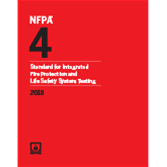NFPA 4, a new world of integration testing is here…

 With the adoption of the 2018 model codes, the new era of integrated fire protection and life safety system testing is upon us. The concept is an easy one. Do the individual building active and passive protection systems interact appropriately together as a single unit?
With the adoption of the 2018 model codes, the new era of integrated fire protection and life safety system testing is upon us. The concept is an easy one. Do the individual building active and passive protection systems interact appropriately together as a single unit?
The 2018 editions of the International Building Code (IBC), International Fire Code (IFC) (901.6.2, 901.6.2.1 & 901.6.2.2), NFPA 1 Fire Code (13.1.3) NFPA 101 Life Safety Code (9.11.4), and NFPA 5000 Building Code (55.1.4.2) now require that some building owners must comply with NFPA 4, the Standard for Integrated Fire Protection and Life Safety Testing.
The Purpose of NFPA 4
NFPA 4 was established to provide verification that all individual systems within a building have an ability to communicate with each other and that they interact together as designed. This is an additional testing requirement beyond the normal individual inspection, testing and maintenance of systems. Building owners are now responsible for establishing an Integrated Testing Team and provide a test plan, including test frequencies, acceptable to the local Authority Having Jurisdiction (AHJ). This team is headed by an Integrated Testing Agent (ITA) who plans, schedules, documents, coordinates and implements all the testing of integrated systems and sub-systems. The developed testing is required to be a complete sequential end-to-end test.
Compliance with NFPA 4 is triggered in all new high-rises and buildings with smoke control systems as identified in the 2018 editions of NFPA 1, NFPA 101, NFPA 5000, IBC, and IFC when two or more fire protection or life safety systems are tied together. All testing is required to be documented, and these requirements and examples of forms can be found in the standard. A full integrated retest is not required upon deficiencies found during testing; however, those deficiencies are required to be repaired and retested individually.
While the standard appears vague and brief, don’t underestimate its overall value to life safety. This design allows the owner to customize the testing plan to the needs of individual buildings while being accountable for the integration of the required fire and life safety systems within their building.
For over a century, the National Fire Sprinkler Association (NFSA) has served as the voice of the fire sprinkler industry. Our mission: advocating to protect lives and property through the widespread acceptance of the fire sprinkler concept. To join NFSA or learn more about the ways membership can benefit your organization, visit nfsa.org/join.
